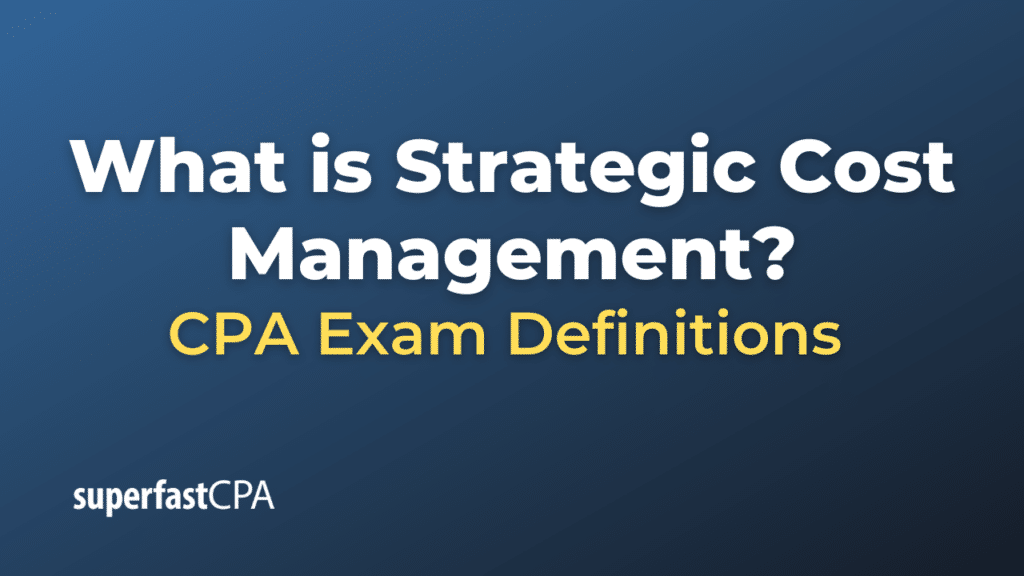Strategic Cost Management
Strategic Cost Management (SCM) is a comprehensive approach to managing and controlling costs with a clear focus on aligning business strategy and operations. Unlike traditional cost management that focuses primarily on reducing costs, SCM takes a broader perspective, aiming to create a competitive advantage for the organization. It emphasizes the importance of understanding how costs relate to the sources of value and differentiation in the company’s products or services.
Key aspects and principles of Strategic Cost Management include:
- Value Chain Analysis: SCM looks at the entire value chain, from raw materials to end customers, to identify areas where costs can be reduced without sacrificing value. This can include sourcing, production, marketing, distribution, and after-sales services.
- Target Costing: This involves setting a desired cost for a product based on a competitive market price and then working backward to determine the allowable cost for each stage of production or service delivery.
- Life Cycle Costing : Instead of just looking at the production cost, SCM considers the total cost of a product over its entire lifecycle, from development to disposal.
- Benchmarking: Comparing the company’s processes and performance metrics to industry bests or best practices from other industries can help identify areas for improvement.
- Continuous Improvement: SCM promotes an ongoing commitment to efficiency and process improvement, often borrowing from methodologies like Six Sigma or Lean.
- Balancing Cost with Strategy: While cost reduction is essential, SCM recognizes that not all costs should be minimized. Instead, costs should align with the company’s strategic priorities. For example, a luxury brand might prioritize product quality and customer experience over mere cost minimization.
- Cost Drivers Analysis: Identifying and understanding the primary drivers of costs can help manage and control them more effectively.
- Performance Measurement: Establishing relevant key performance indicators (KPIs) can help monitor the effectiveness of cost management initiatives and their impact on overall business strategy.
Example of Strategic Cost Management
Let’s consider a detailed example of Strategic Cost Management (SCM) for a fictional company.
Scenario: FreshBites, a Gourmet Salad Chain
Company Profile: FreshBites operates a chain of gourmet salad bars in urban areas. They cater to health-conscious consumers, promising fresh, organic, and locally-sourced ingredients.
Strategic Goal: To be the top gourmet salad bar in major cities while maintaining their commitment to sustainability and quality.
Strategic Cost Management Initiatives:
- Value Chain Analysis:
- FreshBites maps out its entire supply chain, from local farmers to the end consumer.
- They identify a key cost driver in transportation. By sourcing more ingredients from local farmers close to their outlets, they reduce transportation costs and ensure freshness, aligning with their brand promise.
- Target Costing:
- Research shows that customers are willing to pay up to $12 for a gourmet salad.
- FreshBites decides on a profit margin of 25%. They then determine that the cost to produce a salad should not exceed $9.
- They then allocate this cost across ingredients, labor, rent, and other operational costs.
- Life Cycle Costing:
- FreshBites considers the entire lifecycle of their salads. They introduce biodegradable packaging, which might be slightly more expensive upfront but reduces waste disposal costs and strengthens their sustainability branding.
- Benchmarking:
- FreshBites benchmarks its operations against both direct competitors (other salad bars) and indirect competitors (other fast-casual dining options).
- They find that their order-to-serve time is longer than average, leading to longer queues during peak hours.
- An investment is made in staff training and improved kitchen equipment to address this issue.
- Balancing Cost with Strategy:
- While organic ingredients are more expensive, FreshBites continues to source them because it’s core to their brand value.
- However, they negotiate long-term contracts with organic farmers to ensure steady prices and supply.
- Cost Drivers Analysis:
- Labor is identified as another significant cost driver. By introducing a loyalty program and a mobile ordering app, FreshBites encourages off-peak dining and more even distribution of orders throughout the day, optimizing labor costs.
- Performance Measurement:
- FreshBites establishes KPIs, such as average order completion time, monthly customer retention rate, and average ingredient wastage percentage.
- Regular audits ensure that they’re meeting their targets without compromising on quality or sustainability.
Outcome:
Over a year, FreshBites sees an increase in customer retention, reduced wastage, and improved profit margins. While they’ve managed to reduce costs in certain areas, they’ve also strategically invested in others, like technology and staff training. Their commitment to quality and sustainability, coupled with strategic cost management, strengthens their market position and drives growth.
Through this example, we can see how FreshBites applied SCM principles to ensure that cost management decisions directly supported their broader business strategy and brand positioning.












